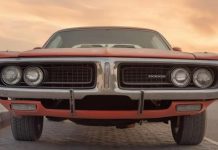*Hip Hop producers have a long, proud history of snatching breaks, choruses, baselines and ad libs from James Brown, so it’s a bit hard to believe that the funk innovator would’ve ever borrowed any funk riff from another artist’s song. Well it happened in 1975, when Brown used the track from David Bowie’s “Fame” for his own single, “Hot (I Need to Be Loved, Loved, Loved, Loved.”
Bowie, a white English artist who defied genres with experimental pop innovations and his androgynous Ziggy Stardust alter-ego, released his straight-up funk driven classic “Fame” in the U.S. on this day in 1975. The lyrics, about the drawbacks of stardom, was a direct answer to his 1972 song “Star” about a teen’s dream of someday being a singing sensation.
As the origin story goes, Bowie was in New York working on the “Young Americans” album when he met John Lennon. Of course, these two hit it off and it leads to a jam session, which took place at the famed Electric Lady Studios, where Bowie was recording at the time. Bowie’s guitarist, Carlos Alomar, started playing the guitar riff that he had developed for Bowie’s cover of “Foot Stompin” by The Flares, which he had been singing on tour. Then Lennon started playing acoustic guitar and repeating, “Aim,” over the riff, which Bowie changed to “Fame.” Lennon said of the song’s groove in a 1980 interview: “We took some Stevie Wonder middle eight and did it backwards, you know, and we made a record out of it!”
Alomar later told Mojo magazine of the riff: “In funk music, what you want to do is put down a lot of holes, leaving a little space for someone to be able to dance in. Lennon played acoustic guitar and we reversed it and that’s the suction sound you hear at the beginning. Then we put up big reverb upon David’s riff. Like going to a recreation center when it’s empty, taking your amplifier and your guitar – and filling that room.”
Bowie then wrote the lyrics, inspired by his own “upsetting management problems,” and Lennon’s falsetto interjections of “fame” were left on the track, echoing Bowie’s use of the word throughout the song. The word “Fame” is famously repeated 23 times in a row spanning four octaves toward the song’s end.
“Fame” was released in the U.S. on June 28, 1975 as the second release off “Young Americans.” It became Bowie’s first big U.S. hit and first single to top the Billboard Hot 100, where it stayed for two non-consecutive weeks.
Six months later, James Brown straight jacked Alomar’s guitar riff for “Hot (I Need to Be Loved, Loved, Loved, Loved),” the first single from his December 1975 album, “Hot.” Listen below.
The Godfather of Soul likely had no qualms about borrowing another man’s funk riff because Alomar was briefly a member of Brown’s band in the late 1960s. But did JB sample “Fame,” or have his air-tight band play it note for note? This musician who pondered the question in a YouTube video believes Brown actually sampled Bowie’s track, and explains why.
Alomar, a self-taught guitarist from Ponce, Puerto Rico, is best known for his run with Bowie, which lasted from the mid-1970s to the early 2000s. According to Bowie’s biography “Strange Fascination,” Alomar once considered suing Brown over the “Fame” theft, but ultimately felt it wasn’t worth it because Brown’s version never became a hit.

Alomar ended up playing on more Bowie albums than any other musician. He also worked with Paul McCartney, Mick Jagger, Chuck Berry, Bette Midler, Arcadia, Digable Planets, the Bee Gees, Tina Turner, Whitney Houston, Bruce Springsteen, Carly Simon and Duran Duran.
“Fame” was recorded at the Sigma Sound studios in Philadelphia, where many ’70s soul staples were made. Bowie wanted an R&B feel for the “Young Americans” album, and he called the sound he crafted “Plastic Soul.”
He took “Fame” to “Soul Train” on November 4, 1975, making him one of the first white artists to appear on the show. He reportedly had a few drinks before his performance to calm his nerves, and actually credited James Brown during the Q&A for getting him into soul music. This episode aired one month before Brown’s “Fame” jacking single was released.
Watch the Q&A and performance below:
David Bowie – Fame 1975 – Soul Train (remastered) from mister sussex on Vimeo.
For those who could never make out what Bowie was saying in certain parts of the song, here are the lyrics … we think:
Fame (fame) makes a man take things overFame (fame) lets him loose, hard to swallowFame (fame) puts you there where things are hollowFame (fame)Fame not your brain it’s just the flameThat burns your change to keep you insane (sane)Fame (fame)Fame (fame) what you like is in the limoFame (fame) what you get is no tomorrowFame (fame) what you need you have to borrowFame (fame)Fame, “Nein! It’s mine!” is just his line
To bind your time, it drives you to a crime (crime)Fame (fame)Could it be the best could it be?Really be really babeCould it be my babe could it babe?Could it babe could it babe?Is it any wonder I reject you firstFame (fame) fame fameIs it any wonder you are too cool to foolFame (fame)Fame bully for you chilly for meGot to get a rain check on pain(Pain)FameFame fame fame fame fameFame fame fame fame fameFame fame fame fame fameFame fame fame fame fameFame fame fameFameWhat’s your name?What’s your name?What’s your name?…Feeling so gay (or “Brings so much pain,” this continues to be debated.)
BTW… Carlos Alomar is also credited with “discovering” Luther Vandross. The musician recruited the vocal talent to sing behind Bowie for the “Young Americans” album, which ultimately led to Vandross’ successful solo career.
Vandross co-produced Bowie’s song “Fascination,” which is track #3 on “Young Americans.” But it was originally sung by Vandross and his band “Luther” with the title “Funky Music” under his deal with Atlantic’s Cotillion Records.
Listen to both Vandross and Bowie’s versions of the song below.
Below, Carlos Alomar reflects on his life and talks about playing with Brown and other “icons of American history.” He also discusses his influence on Bowie (at the 1:21 mark). Footage includes a clip of Vandross singing background during a performance of “Young Americans” (at the 1:58 mark).
Watch below:
MORE NEWS ON EURWEB: Jonathan Majors Files Domestic Violence Complaint Against Ex-Girlfriend
We Publish News 24/7. Don’t Miss A Story. Click HERE to SUBSCRIBE to Our Newsletter Now!





